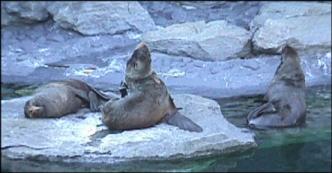Fur Seal

In June, male seals, called bulls, compete to establish breeding territories before the females, or cows, arrive on the beaches. Each bull gradually acquires a harem of up to 40 cows. Within 48 hours of arriving at the breeding site, each cow gives birth to a single, small, black pup that was conceived during the previous year's mating season. Several days later the female mates with a dominant bull and, after suckling her pup for a few days, returns to the sea to hunt. After three months the pups are weaned, and they accompany the females on their migration south. The males remain in their territories for three months without eating.
Male and female seals come together only during breeding season. Once they are mature, males never stray far from the breeding area. Females, however, make and annual migration to hunt in waters are far south as California. Much more agile than true seals (which do not have external ears), the northern fur seal uses its hind flippers to move quickly over short distances. When swimming, true seals propel themselves through the water almost entirely by their hind flippers, but the fur seal uses both its webbed front flippers as well as its hind flippers. The northern fur seal's senses are well developed, but how it navigates underwater is still unknown. Scientists believe that it may rely on the taste or smell of various ocean currents for guidance.
The northern fur seal spends most of its life hunting for food in the north Pacific. Its main food is fish, although it also eats squid and crustaceans. Like other seals, the northern fur seal uses its whiskers to catch fish. During the breeding season the females leave their pups regularly to make extended hunting trips. They travel distances of up to a hundred miles and are often gone for seven or eight days. The seals swim, rest, and sleep on the surface of the water until they reach suitable feeding grounds. They hunt mainly at night and can stay submerges for periods of up to seven minutes at a time.
By 1834 fur traders had nearly wiped out the Pribilof northern fur seals. Other nations also endangered seals by killing them at sea. In 1911 the United States, Great Britain, Japan and the Soviet Union agreed to honor prohibitions outlawing the killing of fur seals at sea and to conduct studies to find ways of preventing further decline.
It lives in mainly in the Pribilof and Commander Islands in the Bering Sea, but small populations are found on islands in the sea of Okhotsk and off California. Hunting stopped in the United States in 1985, but 9,000 seals a year are still killed in the Soviet Union. Population decline over the last 30 years appears to have leveled off.
We got our information from the "Wildlife Fact File".
Front Page
